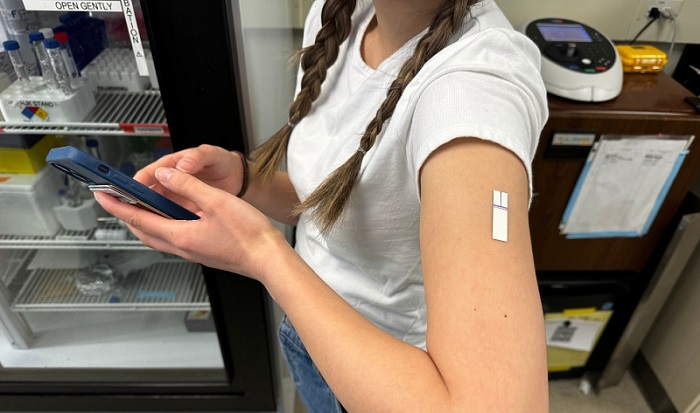Painless Skin Patch Continuously Monitors Vital Health Biomarkers
|
By HospiMedica International staff writers Posted on 19 Jun 2024 |

Researchers have designed a pain-free, wearable sensor capable of continuously monitoring levels of glucose, lactates, and other vital health indicators for weeks, transmitting the data to a smartphone or similar device. This wearable patch features an array of tiny hydrogel needles that penetrate just deep enough to tap into the interstitial fluid under the skin, without reaching the blood vessels or nerves. It collects and relays data about biomarkers in the fluid to an electronic device, providing a continuous record of variations in important health markers. After it is developed for clinical use, this device will enable health professionals to access up-to-date medical information that is currently only obtainable retrospectively through blood tests and lab analyses. This innovation could simplify monitoring disease markers as easily as checking pulse or blood pressure.
The Wearable Aptalyzer developed by researchers from McMaster University (Hamilton, ON, Canada) and the University of Waterloo (Waterloo, ON, Canada) can serve as a versatile platform that is capable of measuring a wide range of biomarkers, from those related to diabetes to cardiac indicators. The patch, applied and removed much like a small bandage with barely visible, soft hooks, offers convenience that will be particularly appealing to diabetics and others who currently test themselves by drawing blood or using more invasive solid monitoring patches. The technology’s most significant advantage, however, could be its ability to deliver extended, meaningful data over weeks and transmit this information directly to electronic devices accessible by medical professionals without the need for complex equipment.
Furthermore, the Wearable Aptalyzer could potentially transform how data indicating cardiac events is captured and transmitted in real time, which would be invaluable in ambulances, emergency rooms, and throughout ongoing patient care. The technology can also be adapted to monitor a variety of chronic conditions, including cancer. It has significant potential to enhance medical care in remote settings, such as in northern Indigenous communities who reside at a distance from medical facilities. The data provided by the Wearable Aptalyzer can indicate emerging health issues before symptoms are evident, potentially facilitating timely medical intervention. The next steps for this technology include conducting human trials and obtaining regulatory approvals, with the researchers actively seeking partnerships to commercialize the innovation.
“This technology can provide real-time information about both chronic and acute health conditions, allowing caregivers to act more quickly and with greater certainty when they see trouble,” said, McMaster’s Leyla Soleymani, professor of Engineering Physics.
Related Links:
McMaster University
University of Waterloo
Latest Critical Care News
- Novel Cannula Delivery System Enables Targeted Delivery of Imaging Agents and Drugs
- Ingestible Smart Capsule for Chemical Sensing in the Gut Moves Closer to Market
- Novel Intrabronchial Method Delivers Cell Therapies in Critically Ill Patients on External Lung Support
- Generative AI Technology Detects Heart Disease Earlier Than Conventional Methods
- Wearable Technology Predicts Cardiovascular Risk by Continuously Monitoring Heart Rate Recovery
- Wearable Health Monitoring Device Measures Gases Emitted from and Absorbed by Skin
- Groundbreaking Technology Rapidly Detects Airborne Influenza Viruses
- Handheld Device Could Transform Heart Disease Screening
- Flexible Semi-Autonomous Robot Could Deliver Medicine Inside Body

- Neurorestorative Treatment Strategies Hold Promise for Most Severe Forms of Epilepsy
- Gene Discovery Could Help Grow New Heart Arteries
- Study Discovers Invisible Transmission of Common Hospital-Associated Infection
- Non-Invasive Neuro-Ophthalmology Techniques Could Detect Brain Tumors Earlier
- Mass Manufactured Nanoparticles to Deliver Cancer Drugs Directly to Tumors
- World’s Smallest Pacemaker Fits Inside Syringe Tip

- AI-Powered, Internet-Connected Medical Devices to Revolutionize Healthcare, Finds Study
Channels
Surgical Techniques
view channel
Pioneering Sutureless Coronary Bypass Technology to Eliminate Open-Chest Procedures
In patients with coronary artery disease, certain blood vessels may be narrowed or blocked, requiring a stent or a bypass (also known as diversion) to restore blood flow to the heart. Bypass surgeries... Read more
Intravascular Imaging for Guiding Stent Implantation Ensures Safer Stenting Procedures
Patients diagnosed with coronary artery disease, which is caused by plaque accumulation within the arteries leading to chest pain, shortness of breath, and potential heart attacks, frequently undergo percutaneous... Read more
World's First AI Surgical Guidance Platform Allows Surgeons to Measure Success in Real-Time
Surgeons have always faced challenges in measuring their progress toward surgical goals during procedures. Traditionally, obtaining measurements required stepping out of the sterile environment to perform... Read morePatient Care
view channel
Portable Biosensor Platform to Reduce Hospital-Acquired Infections
Approximately 4 million patients in the European Union acquire healthcare-associated infections (HAIs) or nosocomial infections each year, with around 37,000 deaths directly resulting from these infections,... Read moreFirst-Of-Its-Kind Portable Germicidal Light Technology Disinfects High-Touch Clinical Surfaces in Seconds
Reducing healthcare-acquired infections (HAIs) remains a pressing issue within global healthcare systems. In the United States alone, 1.7 million patients contract HAIs annually, leading to approximately... Read more
Surgical Capacity Optimization Solution Helps Hospitals Boost OR Utilization
An innovative solution has the capability to transform surgical capacity utilization by targeting the root cause of surgical block time inefficiencies. Fujitsu Limited’s (Tokyo, Japan) Surgical Capacity... Read more
Game-Changing Innovation in Surgical Instrument Sterilization Significantly Improves OR Throughput
A groundbreaking innovation enables hospitals to significantly improve instrument processing time and throughput in operating rooms (ORs) and sterile processing departments. Turbett Surgical, Inc.... Read moreHealth IT
view channel
Printable Molecule-Selective Nanoparticles Enable Mass Production of Wearable Biosensors
The future of medicine is likely to focus on the personalization of healthcare—understanding exactly what an individual requires and delivering the appropriate combination of nutrients, metabolites, and... Read more
Smartwatches Could Detect Congestive Heart Failure
Diagnosing congestive heart failure (CHF) typically requires expensive and time-consuming imaging techniques like echocardiography, also known as cardiac ultrasound. Previously, detecting CHF by analyzing... Read moreBusiness
view channel
Expanded Collaboration to Transform OR Technology Through AI and Automation
The expansion of an existing collaboration between three leading companies aims to develop artificial intelligence (AI)-driven solutions for smart operating rooms with sophisticated monitoring and automation.... Read more
















